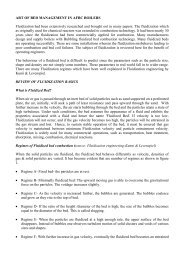Create successful ePaper yourself
Turn your PDF publications into a flip-book with our unique Google optimized e-Paper software.
The new mix<strong>in</strong>g nozzle had reduced the air flow as <strong>in</strong>dic<strong>at</strong>ed by the air flow measurement and the<br />
power consumption. The high suction th<strong>at</strong> could be cre<strong>at</strong>ed helped <strong>in</strong> suck<strong>in</strong>g the wet coal without<br />
caus<strong>in</strong>g a bridg<strong>in</strong>g effect and venturi thro<strong>at</strong>. The fuel feeder floor is now clean and the leg chute<br />
jamm<strong>in</strong>g by wet coal is reduced drastically. The fuel feeder was seen to be <strong>at</strong> high vacuum as can be<br />
seen from photographs.<br />
Comparison of power consumption by PA fan <strong>in</strong> <strong>boiler</strong> 1 & 2<br />
The new mix<strong>in</strong>g nozzle consumed 107.4 kW as aga<strong>in</strong>st 177.4 kW to produce the m<strong>in</strong>imum vacuum <strong>at</strong><br />
thro<strong>at</strong>. However the <strong>boiler</strong> oper<strong>at</strong>ors now preferred to keep higher header pressure so th<strong>at</strong> the bridg<strong>in</strong>g<br />
of wet coal <strong>in</strong> leg chute was reduced gre<strong>at</strong>ly. The power consumed for the same is 120.5 kW. On the<br />
net compar<strong>in</strong>g <strong>boiler</strong> 1 & 2, there is a power sav<strong>in</strong>g of 57 kW.<br />
Wh<strong>at</strong> could be the reason for reduced fan efficiency?<br />
For the condition of 1520 mmWC header pressure, the fan power should have been 86 kW only (with<br />
an efficiency of 70% as per fan performance curve) as aga<strong>in</strong>st present 120.5 kW. If the header<br />
pressure was only 1304 mmWC, with a fan efficiency of 70%, the fan power should have been only<br />
50 kW. At least one can say, there is a loss of 120.5-86 = 34.5 kW now by virtue of poor efficiency of<br />
PA fan. The reason can be defective <strong>in</strong>let conditions assum<strong>in</strong>g the impeller design is correct.<br />
<br />
<br />
<br />
It is possible th<strong>at</strong> the suction box is undersized produc<strong>in</strong>g an effect of 90 deg turn <strong>at</strong> <strong>in</strong>let of fan.<br />
Further the IGV provided <strong>at</strong> fan <strong>in</strong>let with a high entry velocity can be an added disadvantage. The<br />
preferred free length <strong>at</strong> front of fan has to be three times the <strong>in</strong>let diameter.<br />
The recircul<strong>at</strong>ion of air flow through standby fan is possible. Guillot<strong>in</strong>e g<strong>at</strong>e elim<strong>in</strong><strong>at</strong>es the<br />
possibility of recircul<strong>at</strong>ion.<br />
Problem bridg<strong>in</strong>g <strong>in</strong> mix<strong>in</strong>g <strong>in</strong>let chute & leg chute<br />
Dur<strong>in</strong>g the visit, the problem of leg chute chok<strong>in</strong>g was studied. When the mix<strong>in</strong>g nozzle develops<br />
neg<strong>at</strong>ive pressure, the fuel th<strong>at</strong> is fed <strong>in</strong>to the mix<strong>in</strong>g nozzle flows freely. In case of any occasion of<br />
chok<strong>in</strong>g <strong>at</strong> thro<strong>at</strong> cross by a coal powder lump, the positive pressure cre<strong>at</strong>ed <strong>at</strong> thro<strong>at</strong> leads to bridg<strong>in</strong>g<br />
of wet coal <strong>in</strong> the mix<strong>in</strong>g nozzle <strong>in</strong>let chute. This is unavoidable. On <strong>in</strong>spection of each chute <strong>at</strong><br />
mix<strong>in</strong>g nozzle <strong>in</strong>let, the follow<strong>in</strong>g po<strong>in</strong>ts were noted to be a concern for bridg<strong>in</strong>g of wet coal.<br />
<br />
<br />
<br />
It was seen th<strong>at</strong> the SS l<strong>in</strong>er pl<strong>at</strong>es were tack / stitch welded to chutes. These weld beads offered as<br />
sites for the dust to build up. Instead of l<strong>in</strong>er pl<strong>at</strong>es, the chute should have been made of SS pl<strong>at</strong>es.<br />
Or else the l<strong>in</strong>er pl<strong>at</strong>es should have been plug welded from back, through some drilled holes <strong>in</strong> the<br />
chute.<br />
It was seen th<strong>at</strong> the flange sett<strong>in</strong>g was not proper <strong>in</strong> a chute th<strong>at</strong> was removed for <strong>in</strong>spection.<br />
It was seen th<strong>at</strong> the pack<strong>in</strong>g ropes were project<strong>in</strong>g <strong>in</strong>side the coal flow p<strong>at</strong>h. These can form sites<br />
for coal dust to build up.<br />
F<strong>in</strong>al conclusion<br />
<br />
<br />
<br />
The mix<strong>in</strong>g nozzles have met the <strong>in</strong>tentions of its purpose of achiev<strong>in</strong>g suction effect with lesser<br />
air flow.<br />
The mix<strong>in</strong>g nozzle <strong>in</strong>let chutes need to be corrected for smooth flow of coal.<br />
The PA fan needs a properly designed suction box to reduce the power consumption.


















